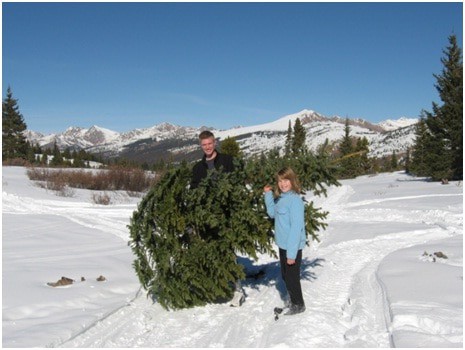
Last year this time, we took a trip not far from our home in Colorado up to Vail Pass to hunt for our Christmas tree. Frustrated by trees that dry out too fast, we decided to get the freshest tree possible. Taking our four wheel drive vehicle off road, we found a subalpine forest at about 11,000 feet, and with permit in hand, trudged through snow to find “the perfect tree.”
Of course, not all Christmas tree outings are so idyllic. This year, now relocated in Central Florida, things are very different. We did the typical trip to Home Depot and found a nice “pre-cut tree” from North Carolina!
Actually, the custom of tree cutting is very old. It certainly predates Christian traditions. In Jeremiah 10.1ff we read about the peoples who “cut a tree out of the forest….” But then with the help of craftsmen, they shape it with a chisel, adorn it with silver or gold, and make an idol of it. God warns Israel not to imitate the foolish customs of the peoples.
I sometimes wonder why pagans were into tree worship? Where did the custom come from? Wikipedia confidently asserts that the Christmas tree is an adaptation of pagan tree worship. But might pagan tree worship have been prompted by a distant memory of another tree that once tied us all together? Might it have been tied to a longing to get back to the tree of life?
Early Romans marked the Winter Solstice by cutting trees and placing evergreen boughs in their temples and homes. Druids in Northern Europe did the same. Vikings in Scandinavia thought the evergreen was a special plant of the sun God. During their dark and depressing winters, they found hope by chopping down evergreens and placing them in their homes. Ancient Saxons did the same and then burned them as Yule logs.
In early Christian tradition, a missionary-monk from England named Boniface went to evangelize the Germans. On one trip he came across a group of people who, in Avatar fashion, were worshipping and sacrificing at a huge oak tree. It was Thor’s Oak. Boniface demanded they stop and chop down the tree. When they refused, he defiantly did it himself. The pagan Germans were amazed that he was not immediately struck dead. So they listened to his message. Boniface then found a tiny fir tree growing in the Oak’s roots. This, he said, was a better tree. It was like the tree of life. Not only could winter not kill it, but it stood for eternal life offered to them by Christ.
In the Baltic countries of Europe, during the Middle Ages, evergreen trees were cut and placed outside churches in December. Early on these were referred to, not as Christmas trees, but as “paradise trees.” They were used to explain the story of Adam and Eve and the promise of a redeemer.
In 16th century Germany, the tradition of cutting “Christmas trees” and bringing them into homes is widely associated with Martin Luther. The story is that as he was walking toward home one winter evening composing a sermon he was awed by the brilliance of stars twinkling amidst the evergreens. To recapture this scene for his family, he erected a tree in the main room, and wired its branches with lighted candles. He taught that the tree represented the everlasting love of God that would not fade. And so the tree became a symbol not just of Christmas but of the Christian faith.
This custom spread. It became very popular in the 19th century, first in Austria, then in France and then in England. With the flood of German and British immigrants to North America, the custom took root here, so that by the 1870s, cutting down trees at Christmas time and decorating them in the home became very common.
Of course, the Christmas tree has morphed. Today they are electrified, often artificial, and decorated with everything imaginable—bows, snowflakes, pink flamingos, and even pictures of ourselves and our hobbies. Not only are modern Christmas trees often fashion statements, they are usually quite secular.
Let us honestly admit that this whole tree business did not originate with Christians. But let’s further admit that it most likely did not even originate with pagans. Let’s push things back further and consider the prominence of sacred trees in the Bible. I’d like to suggest that this whole tree business and our quest for the perfect tree got started here.
There are three main tree stories in the Bible, and none of them are Christmas trees!
First, at the beginning of the Bible we read that God placed Adam and Eve in a paradise filled with trees, but two trees stand out. In Genesis 2 we read about the tree of life and the tree of the knowledge of good and evil. The tree of life represents life in its highest potency—eternal life. The tree of the knowledge of good and evil is a tree of unlimited knowledge. It was a good tree but humanity was warned not to eat from it or they would die. In an act of defiance, Adam and Eve pursued knowledge apart from God. Their sin consisted of an illicit reach of unbelief. In eating of its fruit they disobeyed God. As a consequence, sin took control of their very hearts. They were cut off from the tree of life.
At the beginning of the Bible the reader is confronted with a serious issue–how could this couple and their race get back to the tree of life?
That’s where we encounter a second great tree in the Bible—the tree of Calvary. Access to the tree of life could only be granted by directly confronting humanity’s great sin. It would involve the sending of another Adam whose story would embrace a cross.
Remember, in the Bible the cross is often referred to as a tree. They killed Jesus “by hanging him on a tree” (Acts 10.39). “Cursed is everyone who is hung on a tree” (Galatians 3.13). The tree here is a tree of execution, perhaps recalling a time when criminals were nailed not to cross beams but literal trees.
1 Peter 2.24 says that Christ “bore our sins in his body on the tree” so that we might die to sin and live for righteousness. It is “by his wounds” that we are healed. It was through dying on this the tree of Calvary that the second, greater Adam reopened access to paradise, but only on God’s terms. By paying the deep price for our own sins, even though he did not deserve to, and by taking our curse upon himself, God offered humanity a way of escape from sin’s death grip. As an old hymn says, “Christ has opened paradise.” How? By dying on this second tree, God provided a way of escape—granting access back to his presence.
Is it any wonder that when you come to the last pages of the Bible, yet another tree appears? The tree of Revelation is the tree of life. Revelation 22.14 says “Blessed are those who wash their robes, that they may have the right to the tree of life and may go through the gates into the city.” The one who announces this blessing is the Alpha and the Omega, the first and the last. This is Jesus, the root and offspring of David. Having removed our curse by the cross-tree, access to God’s life-giving blessings is restored. Eternal life is now available through Christ and his tree. Not only that, but this tree’s leaves are for the healing of the nations!
Is it any wonder that the Bible ends with an invitation to come and eat from the tree of life?
Look, you could put it this way. The entire storyline about the Bible is a quest for the perfect tree. That tree is found, not in a Home Depot, or a corner lot, or even in the idyllic setting of Vail Pass in winter. It is found in a far more sacred place.
As you are searching for your tree this year, perhaps even cutting your own, let a recollection of God’s tree of life refresh your memory and bring new life into your Christmas rituals. Think of your tree as a reminder of the tree of promise! You might even go further and re-Christen your tree and its decorations. Let your tree reflect His goodness. Rather than imitating the foolish customs of the peoples, use it to celebrate the wondrous coming of the second Adam.
